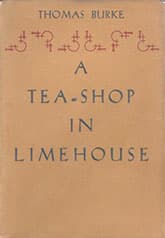The Hands of Mr. Ottermole
Critique • Quotes
 First edition of 1931 collection
First edition of 1931 collectionFirst publication
1931 in collection A Tea-Shop in Limehouse
Literature form
Story
Genres
Mystery, crime, horror
Writing language
English
Author's country
England
Length
Approx. 7,500 words
Murder ahead of time
In 1949 "The Hands of Mr. Ottermole" was selected by critics as the best mystery story of all time and thirty-five years later The Mystery Writers of America voted Thomas Burke's effort one of the top four mystery and suspense tales for its Mystery Hall of Fame. The story continues to appear in anthologies as one of the classics of the field.
This may perplex readers who are not critics, crime writers or aficionados of the genre's past glories. Today they may find "The Hands of Mr. Ottermole" sensational, melodramatic and overheated, in the vein of genre writers trying to appear more mainstream.
Still readers are bound to be pleasantly surprised by its twisted, and potentially brutal, ending—which is still effective.
Apart from that clever denouement, the virtues of this story lie largely in the writing (no surprise there), but specifically in how different the writing is from everything else in the crime and mystery field in 1931:
• Both the comfortable drawing-room style of the British tradition and the rat-a-tat approach of the emerging American hardboiled style are eschewed in favour of something more like an intense literary effect, dense with psychological insight and sociological commentary. (This seems akin to what several decades later Harlan Ellison attempted in the science fiction field with work like his Deathbird Stories.)
• The crimes—a series of strangulations in London—are without connection. They present no pattern to enable the success of a procedural investigation.
• The killer is without motive or remorse. This may be standard in crime tales today, abounding with psychopathic serial killers, but back then fictional murders were most often performed by ladies and gentlemen who had their rationales. Sexual jealousy, adultery, inheritances, blackmail, disputed wills—none of the usual motives apply in this case.
• The killer is finally identified not by a more clever detective but mainly by accident. (Notice, I said "identified", not "caught". Another departure from the usual.)
Brilliant misdirection
These and other features are such that "The Hands of Mr. Ottermole" is often thrown into the horror and fantasy camps, though actually there are no supernatural elements in the story. It only seems there must be because the tale seems so irrational, compared to other detective stories of its time.
The creative narration of the story is itself discombobulating, jumping around among the perspectives of the author and the killer and the victims and an investigating reporter—but accomplished more elegantly than this sounds. It even switches to second person at one point to warn a victim away (in vain).
The title itself is also a subtle bit of misdirection, naming the killer in a way that leads you away from the killer's identity. And the story's text is managed brilliantly to continue misleading you without you noticing it. (At least without me noticing it.)
Burke is often derided as a sensationalist hack and there were times reading "The Hands of Mr. Ottermole" for the first time I thought it was really going over the top. But, maybe because I have a fondness for hacks who ply their trade honestly, overall I found the prose enchanting.
It's been done better since then—the style and all those unusual features have been adopted by many writers over the past century—but this odd story can be revered for being ahead of its time.
— Eric
Critique • Quotes

